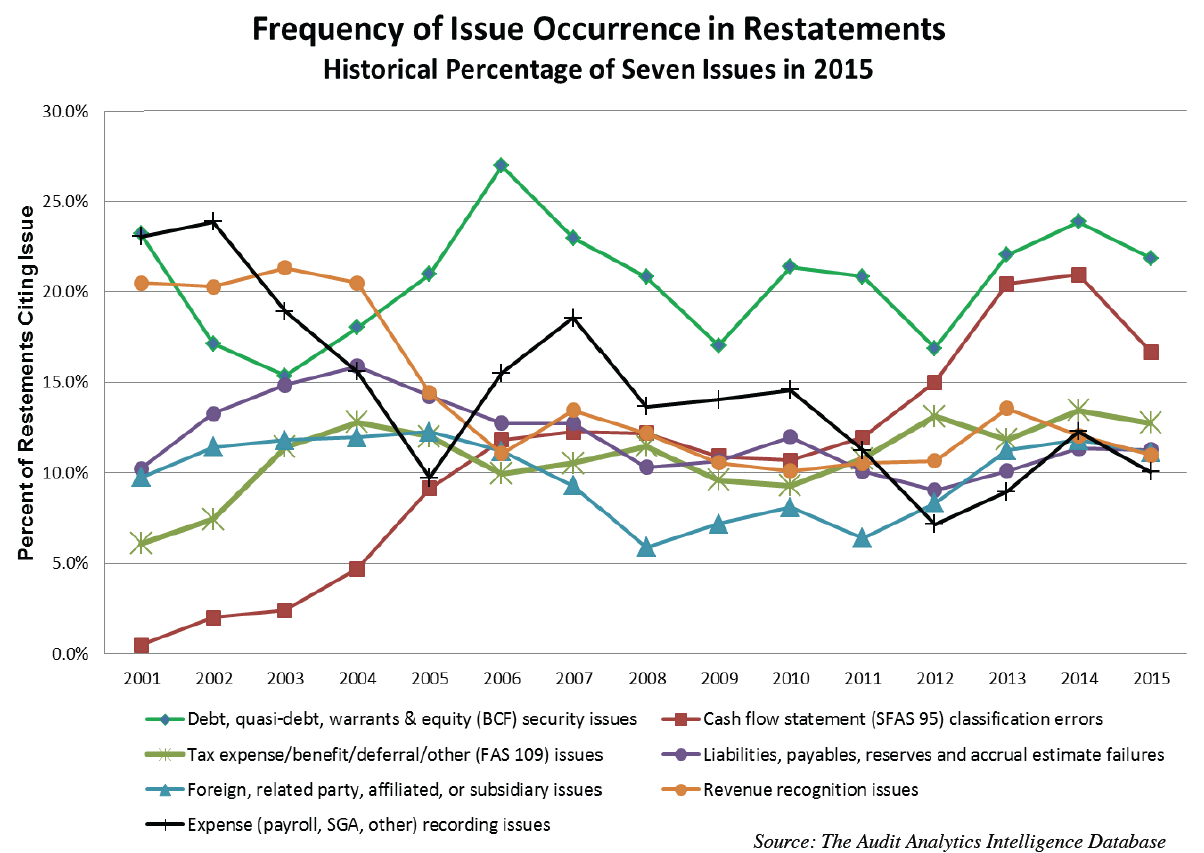For a number of years we experienced a “lull” in significant accounting standards issued by the FASB. However, just within the last two years, the FASB has issued two significant, complicated accounting standards that will have far-reaching implications for companies.
These two accounting standards affect how companies recognize revenues and recognize leases. Based on my experience, I expect that just about every company whose financial reporting framework is U.S. GAAP will be affected by at least one, if not both, of these standards. As such, today’s post will focus on what these two standards are and how they will affect companies.
Revenue recognition
In May 2014, the FASB issued Accounting Standards Update (ASU) No. 2014-09, Revenue from Contracts with Customers (Topic 606). This standard is designed to achieve a number of goals. First, the standard removes inconsistencies and weaknesses in revenue requirements and provides a more robust framework for addressing revenue issues. Second, the standard improves comparability of revenue recognition practices across entities, industries, jurisdictions, and capital markets (particularly companies that have adopted IFRS). Third, it provides more useful information to users of financial statements through improved disclosure requirements. Finally, the standard simplifies the preparation of financial statements by reducing the number of requirements to which an entity must refer.
The core principle of the guidance in Topic 606 is that an entity should recognize revenue to depict the transfer of promised goods or services to customers in an amount that reflects the consideration to which the entity expects to be entitled in exchange for those goods or services. With a move away from industry and more prescriptive guidance on recognizing revenue, this standard uses the following five-step model:
- Identify the contract(s) with a customer
- Identify the performance obligations in the contract
- Determine the transaction price
- Allocate the transaction price to the performance obligations in the contract
- Recognize revenue when (or as) the entity satisfies a performance obligation
The desired goals of this standard seem nice on paper and I believe they are a significant step toward improved financial reporting. However, what this means for companies is that they will need to apply a significant amount of resources and thought to achieving the objectives set forth in the standard.
ASU No. 2014-09 has been subsequently amended as follows:
- ASU No. 2015-14, Revenue from Contracts with Customers (Topic 606): Deferral of the Effective Date. This ASU defers the effective date of ASU 2014-09 by one year. For publicly traded companies (referred to in the standard as “public business entities”), the “new” effective date is for annual reporting periods beginning after December 15, 2017, including interim periods within that reporting period. The effective date for all other entities is for annual reporting periods beginning after December 15, 2018, and interim periods within annual periods beginning after December 15, 2019.
- ASU No. 2016-08, Revenue from Contracts with Customers (Topic 606): Principal versus Agent Considerations (Reporting Revenue Gross versus Net). This ASU clarifies the application of the principal vs. agent considerations in U.S. GAAP.
- ASU No. 2016-10, Revenue from Contracts with Customers (Topic 606): Identifying Performance Obligations and Licensing. This ASU does not change the core principle of the standard (Topic 606), but rather expounds on two aspects of recognizing revenue, namely, identifying performance obligations and the licensing implementation guidance.
- ASU No. 2016-12, Revenue from Contracts with Customers (Topic 606): Narrow-Scope Improvements and Practical Expedients. This ASU also does not change the core principle of the standard, but rather provides clarity on narrow aspects of it. These narrow aspects include collectibilty, presentation of sales and other taxes collected from customers, non-cash consideration, and contract modifications and completed contracts upon implementation of the standard.
Accounting for leases
Earlier this year the FASB issued ASU No. 2016-02, Leases (Topic 842). The key change from the existing leasing accounting standard (Topic 840) is that, under the new standard, lessees will need to recognize lease assets and lease liabilities for leases classified as operating leases. For leases with a term of 12 months or less, a lessee is permitted to make an accounting policy election by class of underlying asset not to recognize lease assets and lease liabilities. If a lessee makes this election, it should recognize lease expense for such leases generally on a straight-line basis over the lease term.
This standard is effective for fiscal years beginning after December 15, 2018 for publicly traded companies. Although 2019 seems like a long way into the future, many companies will need to make significant endeavors to effectively implement this accounting standard.
Internal coordination a must
It goes without saying that departmental decisions within a company tend to have an effect on accounting and financial reporting. With this in mind, in implementing these new accounting standards companies will need to coordinate internally to ensure that all of the relevant facts and circumstances are gathered for accounting and financial reporting consideration.
In the spirit of coordinating between the accounting function and other departments to ensure that business operations are not adversely affected by adoption of these new accounting standards, following are things to consider:
- Legal – In implementing the new lease standard, leases with terms greater than 12 months will be included in the balance sheet. Companies will need to revisit their contractual terms, particularly with lenders, to ensure that the accounting changes on the balance sheet do not adversely affect compliance with debt covenants. Further, companies will need to consider implications of adopting these two standards on securing financing. Finally, companies may wish to revisit the terms and conditions, including pricing structure, in customer contracts and consider how adoption of the new revenue recognition standard may affect the timing of revenue recognition.
- Financial planning and analysis – Companies will need to consider the timing of revenue recognition for internal budgeting and forecasts.
- Information technology – Companies will need to revisit their accounting and operational systems and processes. Specifically, systems and processes will likely need to be reconfigured and/or reports may need to be modified or created to obtain relevant data for appropriate accounting and more extensive accounting disclosures.
- Human resources – Often times variable compensation is based on key financial metrics, such as revenues, earnings, and EBITDA. With the adoption of the new accounting standards, because the timing of revenue recognition may change, companies will need to revisit their variable compensation arrangements with employees to ensure that targets are reasonable and achievable. Moreover, companies will need to ensure there is adequate staffing with the right level of experience and technical skills to implement these standards.
- Tax – With expected changes in the recognition of revenue, for example, companies will need to consider the impact on income taxes.
- Investor relations – Companies will need to consider changes to guidance provided to the street on revenues, EPS, and non-GAAP measures (such as EBITDA) as these metrics will be affected by adoption of these new accounting standards. Furthermore, companies will need to consider the nature and extent of communications with users of their financial statements regarding expected changes to business practices from adopting these standards.
As I indicated in a previous post, just like individuals, companies can procrastinate decision-making until it becomes costly. Of particular concern in light of these two significant accounting standards is that companies may lack sufficient resources to effectively adopt them, either in terms of quantity or quality of headcount.
Likewise, companies may not provide adequate budgeting for additional resources needed to effectively adopt these standards. Many companies, whether by choice or out of necessity, may find themselves hiring consultants carrying price tags higher than internal resources to accomplish the following two objectives. First, they will need to meet the adoption requirements in the accounting standards. Second, they will need to satisfy their external auditor of compliance with these accounting standards.
Potentially costly audits
In my line of business, hiring outside assistance to pass financial statement audits can become costly in a relatively short period of time. With this in mind, in connection with an audit of financial statements, public companies should be mindful of the implications that the adoption of these standards will have on internal controls over financial reporting.
In essence, there are multiple “types” of internal controls: IT general, application, automated, manual, and IT-dependent manual controls. As is typical of significant changes in accounting and disclosure, the adoption of these new standards will likely require more manual-type controls to verify that financial reporting is reliable.
In light of this, companies will need to consider the increased risk of material misstatement that manual controls introduce to an audit.
Next steps
For these reasons companies should begin now planning for these scenarios. In reality, these new accounting standards are a significant undertaking and companies should approach implementation of these standards with a high degree of determination.
Photo credit





